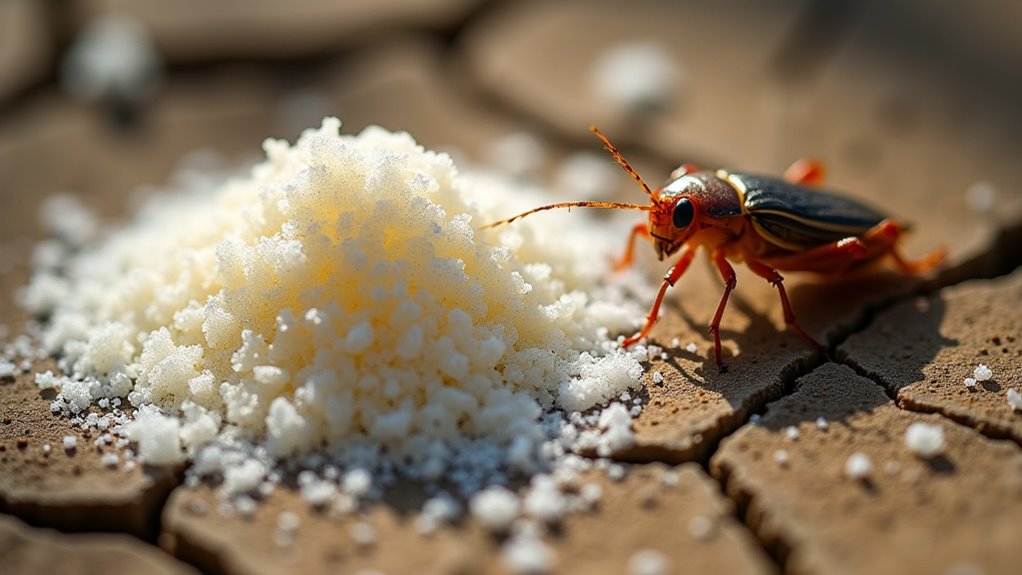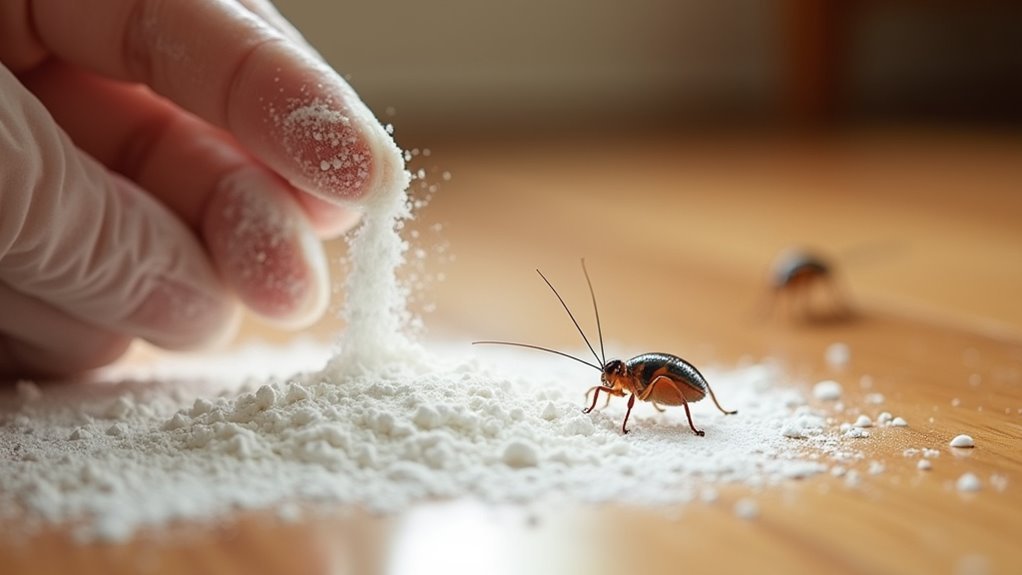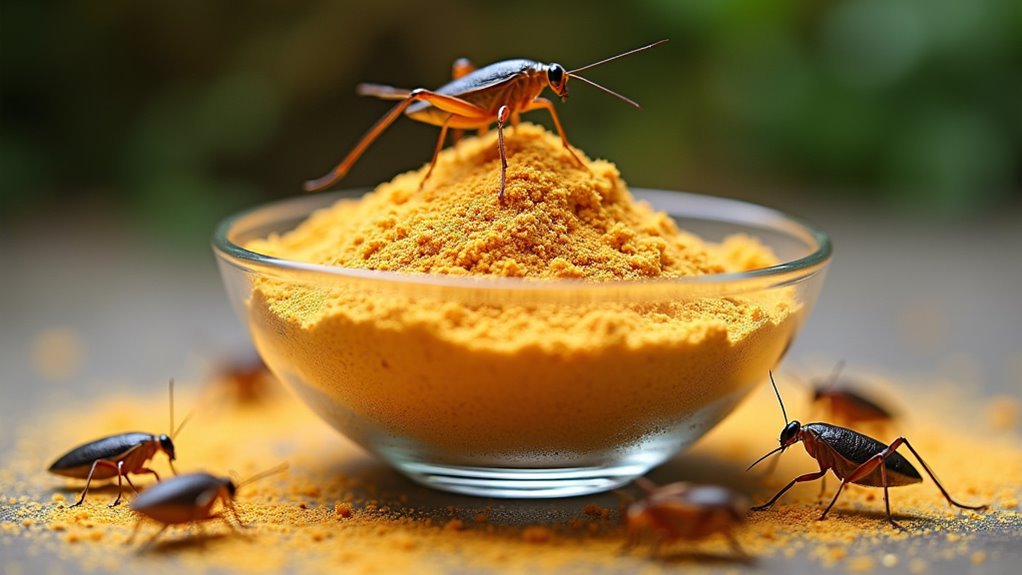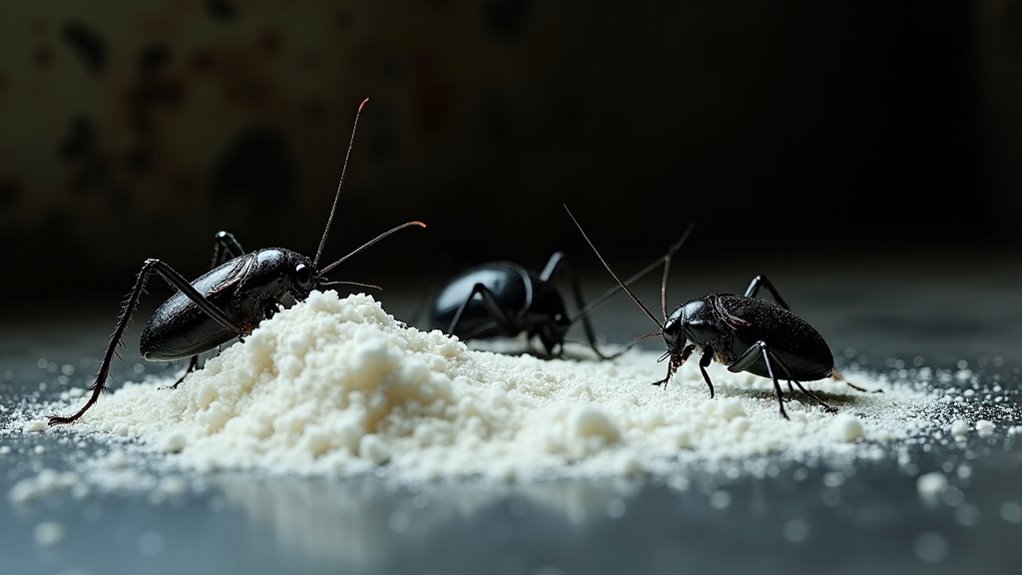You’ll find boric acid eliminates crickets more effectively than other methods because it attacks their digestive and nervous systems simultaneously, creating a dual-action poison that works through both contact and ingestion. When crickets encounter the powder, it adheres to their bodies and gets consumed during grooming, disrupting nutrient absorption and causing complete system failure. Unlike repellent sprays, boric acid’s non-repellent formula actually attracts crickets while providing long-lasting protection for up to three months, making it superior to natural methods that only deter insects temporarily.
How Boric Acid Disrupts Cricket Biology

When crickets encounter boric acid, this natural pesticide immediately begins attacking their internal systems through multiple pathways. The compound disrupts the stomach and nervous system functions simultaneously, creating a lethal combination that’s impossible for crickets to survive.
Boric acid launches a devastating multi-system attack on crickets, simultaneously destroying their digestive and nervous functions for guaranteed elimination.
You’ll find that boric acid targets their digestive processes first, preventing proper nutrient absorption and causing them to stop feeding entirely.
The powder works through contact and ingestion. As crickets groom themselves after walking through treated areas, they unknowingly consume the toxic substance. This grooming behavior amplifies exposure, ensuring the compound reaches their internal organs effectively.
The biological disruption causes complete system failure, making boric acid an extremely reliable method to kill crickets in your home or property.
Application Methods for Maximum Cricket Elimination
Understanding how boric acid eliminates crickets sets the foundation for proper application techniques that maximize its lethal potential.
You’ll get best results when you apply the pesticide according to manufacturer instructions in areas where crickets congregate. Focus on cracks, crevices, and corners where these insects typically hide during daylight hours.
Create deadly bait stations by mixing equal parts boric acid and sugar, encouraging crickets to consume the lethal mixture.
Apply dust, strips, or pellets directly in high-traffic zones where crickets will contact the substance. Products containing boric acid work effectively when you maintain clean environments by vacuuming regularly and removing clutter that provides hiding spots.
Monitor treated areas consistently and reapply as needed to maintain population control.
Safety Precautions When Using Boric Acid Around Homes

When you’re using boric acid to eliminate crickets, you’ll need to prioritize the safety of children and pets who could accidentally ingest this harmful substance.
You should focus your application efforts on areas that aren’t easily accessible to household members, such as behind appliances, inside wall cracks, or underneath furniture.
If you’re concerned about safety risks in your specific living situation, you’ll want to explore alternative cricket control methods that pose fewer hazards to your family.
Child and Pet Protection
Although boric acid offers an effective solution for cricket control, you’ll need to take special precautions to protect children and pets from potential harm.
This child and pet protection approach requires strategic application in areas they can’t easily access, as ingestion or prolonged skin contact poses health risks.
Store your boric acid products securely out of reach, since even minor exposure can cause nausea or diarrhea.
When applying this pest control solution, wear gloves and a mask while ensuring proper ventilation.
You’ll want to use tamper-resistant bait stations that effectively target crickets while limiting access to vulnerable family members.
Don’t forget to regularly monitor and clean treated areas.
This ongoing maintenance reduces accidental exposure risks while maintaining your boric acid’s effectiveness against cricket infestations.
Proper Application Areas
Strategic placement of boric acid in your home’s hidden areas maximizes cricket elimination while minimizing safety risks. You’ll achieve ideal results by targeting specific application areas where crickets travel while maintaining household safety.
| Recommended Areas | Avoid These Locations |
|---|---|
| Behind appliances | Kitchen counters |
| Wall cracks/crevices | Children’s play areas |
| Basement corners | Pet food bowls |
| Under sinks | Open floor spaces |
Focus your boric acid applications in concealed spaces like gaps between walls, beneath furniture, and inside cabinets where crickets hide. These targeted application areas guarantee the treatment remains effective while protecting family members and pets from accidental exposure. Always use tamper-resistant bait stations in areas where complete isolation isn’t possible, maintaining both cricket control and household safety standards.
Alternative Control Methods
Before applying boric acid for cricket control, you must implement essential safety measures to protect your household members and maintain effective pest management.
You’ll need to target areas where this pest commonly enters while keeping treatments away from children and pets.
Essential safety protocols include:
- Wear protective gloves and a mask during application to prevent skin irritation and respiratory issues from inhaling dust particles.
- Apply boric acid only near entry points like cracks, crevices, and baseboards where children and pets can’t access the treatment areas.
- Store unused product in a secure, locked location away from household members.
Follow manufacturer instructions precisely regarding application amounts. Excessive use increases health risks without improving effectiveness.
Monitor treated areas regularly to guarantee the boric acid remains properly positioned and continues eliminating crickets effectively.
Creating Effective Boric Acid Bait Mixtures

When dealing with persistent cricket infestations, you’ll find that mixing equal parts boric acid and sugar creates one of the most effective homemade baits available. The sugar acts as an irresistible attractant while the boric acid serves as the lethal component that will eliminate crickets once ingested.
Apply small amounts of this mixture in areas where you’ve noticed cricket activity. As crickets walk through the bait, the powder adheres to their bodies. When they groom themselves, they’ll consume the boric acid, which disrupts their stomach and nervous system functions.
For safety, place your bait mixture in tamper-resistant stations to protect children and pets. This mixture remains effective for up to three months outdoors, providing long-lasting cricket control.
Strategic Placement for Optimal Cricket Control
The success of your boric acid treatment depends heavily on where you place it throughout your home. Target areas where crickets congregate and travel most frequently to maximize contact with the substance.
Focus your application on these key locations:
- Corners and baseboards – Apply dust or pellets along wall edges where crickets typically hide during daylight hours.
- Behind appliances – Place boric acid in gaps behind refrigerators, washers, and other large equipment where crickets seek shelter.
- Cracks and crevices – Apply the substance directly into small openings and entry points along the perimeter of your home.
Remember to maintain dry conditions during application, as moisture reduces effectiveness.
Monitor high-activity areas regularly and reapply as needed to combat your cricket infestation successfully.
Comparing Boric Acid to Alternative Cricket Treatments
When you’re choosing a cricket control method, you’ll find that boric acid outperforms most alternatives with regard to effectiveness and longevity.
Natural repellents and traps often fall short because they don’t eliminate the problem at its source, while chemical sprays may repel crickets before they can be effectively controlled.
You’ll get better results with boric acid’s non-repellent formula that actually attracts crickets and continues working for months, unlike other treatments that require frequent reapplication.
Boric Acid Effectiveness
Although numerous cricket control methods exist on the market, boric acid stands out as a superior solution that outperforms most alternatives in several key areas.
When you’re looking to eliminate crickets, boric acid’s effectiveness becomes evident through its unique non-repellent formula that actively attracts and kills these pests rather than simply driving them away. This targeted approach guarantees more thorough elimination compared to traditional pesticides.
The substance’s superior performance includes:
- Long-lasting potency – remains effective for three months outdoors and over a year indoors
- Economic application – requires only 3 oz per 100 sq ft, considerably less than commercial alternatives
- Weather resistance – maintains effectiveness in damp conditions when other treatments fail
You’ll find that boric acid disrupts crickets’ stomach and nervous systems upon contact or ingestion, delivering reliable results.
Natural Method Limitations
While boric acid delivers decisive results against cricket infestations, many homeowners first attempt natural methods that often fall short of expectations.
You’ll find that essential oils and repellents from a natural source of pest control typically only deter crickets without eliminating them. These methods require constant reapplication and monitoring, making them labor-intensive solutions.
When you take steps using diatomaceous earth, you’ll need repeated exposure over time, unlike boric acid which kills crickets after single ingestion.
Natural traps capture individual insects but don’t reduce overall populations effectively. While these alternatives provide temporary relief, they lack the residual protection boric acid offers for up to three months outdoors.
The economic efficiency of boric acid’s low application rate surpasses the continuous costs of natural method maintenance.
Chemical Solution Comparisons
Beyond natural approaches, you’ll discover that boric acid outperforms most chemical alternatives in both effectiveness and safety profiles.
Traditional insecticides often require larger quantities and frequent reapplications, making them costlier and more labor-intensive than boric acid’s economical 1 lb per 1000 sq ft application rate.
Key advantages of boric acid over conventional treatments include:
- Lower toxicity risk – Safer for households with children and pets compared to harsh chemical insecticides
- Non-repellent formula – Attracts crickets instead of chasing them away like pyrethroid insecticides do
- Extended protection – Remains effective for up to three months, outlasting most commercial alternatives
When you choose boric acid, you’ll eliminate crickets more efficiently while minimizing environmental impact and reducing costs associated with repeated treatments.
Environmental Persistence and Long-Term Effectiveness
Since boric acid doesn’t break down easily in environmental conditions, you’ll get consistent cricket control that lasts much longer than traditional pesticides.
The environmental persistence of boric acid means you won’t need frequent reapplications, maintaining effectiveness for up to 90 days outdoors regardless of weather conditions, including rain.
This long-term effectiveness stems from its moisture-resistant formulation that prevents degradation in wet environments while avoiding mold and mildew issues that compromise other pest control methods.
You’ll achieve ideal results using a 10% boric acid concentration rather than weaker 5% solutions.
The economical application rates—just 1 lb per 1000 sq ft outdoors and 3 oz per 100 sq ft indoors—deliver extended protection that outlasts conventional treatments while remaining cost-effective.
Preventing Cricket Reinfestation After Treatment
After successfully eliminating crickets with boric acid treatment, you’ll need to implement strategic prevention measures to stop them from returning.
Preventing cricket reinfestation requires an all-encompassing approach that addresses entry points, habitat management, and ongoing maintenance around your home.
Focus on these essential prevention strategies:
- Seal all access points – Use caulk or weatherstripping to close cracks, crevices, and gaps where crickets might enter.
- Maintain your landscape – Keep lawns trimmed and remove overgrown vegetation that provides cricket habitats.
- Eliminate attractants – Promptly clean food waste and spills while removing clutter that creates hiding spots.
Deploy natural repellents like cinnamon or essential oils near potential entry points.
Regular monitoring helps you detect early signs of cricket activity, allowing prompt intervention before populations reestablish themselves in your treated areas.
Frequently Asked Questions
Does Boric Acid Get Rid of Crickets?
Yes, you’ll find boric acid effectively eliminates crickets by disrupting their stomach and nervous systems. When they walk through it, they’ll ingest the substance while grooming, leading to their death.
Why Does Boric Acid Kill Insects?
You’ll find boric acid kills insects by disrupting their stomach and nervous system functions. When they ingest it during grooming, it damages their exoskeleton and causes dehydration, acting as poison.
Why Is Boric Acid Banned in the USA?
You’re mistaken—boric acid isn’t banned in the USA. It’s EPA-regulated and widely available as a pesticide. You’ll find strict concentration limits and usage guidelines, which might’ve caused confusion about its legal status.
What’s the Best Thing to Kill Crickets?
You’ll find boric acid mixed with sugar works best for killing crickets. The sugar attracts them while the boric acid poisons their nervous system when they groom themselves after walking through it.
In Summary
You’ve now got the complete toolkit for cricket elimination using boric acid. You’ll find it’s one of the most reliable, cost-effective solutions available when you follow proper application methods and safety protocols. Don’t forget to monitor treated areas and reapply as needed. With strategic placement and patience, you’ll achieve long-lasting cricket control while protecting your family and pets from these persistent household invaders.





Leave a Reply